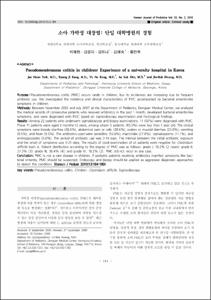소아 가막성 대장염: 단일 대학병원의 경험
- Keimyung Author(s)
- Park, Jae Hyun; Hwang, Jin Bok; Kang, Yu Na
- Journal Title
- Korean Journal of Pediatrics
- Issued Date
- 2010
- Volume
- 53
- Issue
- 2
- Abstract
- Purpose : Pseudomembranous colitis (PMC) occurs rarely in children, but its incidences are increasing due to frequent antibiotic use. We investigated the incidence and clinical characteristics of PMC accompanied by bacterial enteritis-like symptoms in children. Methods : Between November 2003 and July 2007 at the Department of Pediatrics, Dongsan Medical Center, we analyzed the medical records of consecutive patients who received antibiotics in the past 1 month, developed bacterial enteritis-like symptoms, and were diagnosed with PMC based on sigmoidoscopy examination and histological findings. Results : Among 22 patients who underwent sigmoidoscopy and biopsy examinations, 11 (50%) were diagnosed with PMC. These 11 patients were aged 2 months-12 years, among whom 5 patients (45.5%) were less than 1 year old. The clinical symptoms were bloody diarrhea (28.6%), abdominal pain or colic (28.6%), watery or mucoid diarrhea (23.8%), vomiting (9.5%), and fever (9.5%). The antibiotics used were penicillins (55.6%), macrolides (27.8%), cephalosporins (11.1%), and aminoglycosides (5.6%). The period of antibiotic use was 3-14 days. The interval between the initial antibiotic exposure and the onset of symptoms was 5-21 days. The results of stool examination of all patients were negative for Clostridium difficile toxin A. Patient distribution according to the degree of PMC was as follows: grade I, 18.2% (2 cases); grade II, 27.3% (3); grade III, 36.4% (4); and grade IV, 18.2% (2). PMC did not recur in any case. Conclusion : PMC is not a rare disease in children. If pediatric patients receiving antibiotics manifest symptoms like bacterial enteritis, PMC should be suspected. Endoscopy and biopsy should be applied as aggressive diagnostic approaches to detect this condition.
목 적 : 가막성 대장염(pseudomembranous colitis, PMC)은 소아에서는 드문 질환으로 항생제의 사용이 늘어나면서 증가하고 있을 것으로 추정되고 있다. 저자들은 세균성 장염의 소견을 보인 소아 PMC의 발병 빈도와 임상 특성에 관한 단일 대학 병원의 경험을 소개하고자 한다. 방 법 : 2003년 11월부터 2007년 7월까지 동산의료원 소아과에 입원한 환자 중 최근 1개월 이내에 항생제 사용의 병력을 가지면서 세균성 장염 증상을 보인 환자에서 직장 내시경 및 조직 생검을 시행하여 조직학적으로 PMC로 확진된 연속해서 모아진 환자를 대상으로 하였다. 결 과 : 직장 내시경 및 조직 검사를 시행한 22례 중 11례(50.0%)에서 PMC로 진단되었다. 소아 PMC 환자의 연령은 2개월에서 12세로, 1세 이하가 5례(45.5%)를 차지하였다. 혈성 설
사 6례(28.6%), 복통 혹은 보챔 6례(28.6%), 수양성 혹은 점액성 설사 5례 (23.8%), 구토 2례(9.5%), 열 2례(9.5%)가 관찰 되었다. 항생제는 병합 사용된 경우를 포함하여 총 18건이 관찰 되어, 페니실린 계열 10건(55.6%), 마크로라이드 5건(27.8%), 세팔로스포린 2건(11.1%), 아미노글라이코사이드 계열 사용이 1건(5.6%)이었다. 항생제 사용 기간은 3일에서 14일로 다양하였다. 항생제 노출에서 증상 발현까지의 기간은 5일에서 21일이었다. 대변 Clostridium difficile 독소 A 검사는 PMC 환자 전례 에서 음성이었다. 가막성을 기준으로 한 가막성 대장염의 내시경 소견은 1단계(18.2%, 2), 2단계(27.3%, 3), 3단계(36.4%, 4), 4단계(18.2%, 2)였다. 추적 관찰 중 전례에서 재발은 관찰되지 않았다. 결 론 : 소아의 가막성 대장염은 드물지 않으며, 영아기에도 호발한다. 특히 항생제를 사용 중이거나 사용 병력을 가진 환자에서 세균성 장염의 소견을 보일 때 직장 내시경 검사 및 조직 생검을 이용한 적극적인 진단적 접근이 필요할 것으로 판단된다.
- Alternative Title
- Pseudomembranous colitis in children: Experience of a university hospital in Korea
- Publisher
- School of Medicine
- Citation
- 박재현 et al. (2010). 소아 가막성 대장염: 단일 대학병원의 경험. Korean Journal of Pediatrics, 53(2), 184–189. doi: 10.3345/kjp.2010.53.2.184
- Type
- Article
- ISSN
- 1738-1061
- Appears in Collections:
- 1. School of Medicine (의과대학) > Dept. of Pathology (병리학)
1. School of Medicine (의과대학) > Dept. of Pediatrics (소아청소년학)
- 파일 목록
-
-
Download
 oak-aaa-03527.pdf
기타 데이터 / 440.64 kB / Adobe PDF
oak-aaa-03527.pdf
기타 데이터 / 440.64 kB / Adobe PDF
-
Items in Repository are protected by copyright, with all rights reserved, unless otherwise indicated.